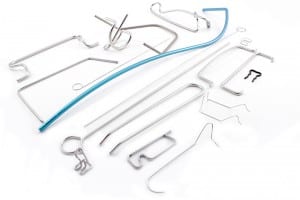 Wire forms or, more specifically, wire forming, is a fabrication technique that utilizes blanks of metal wire which is manipulated into standard or customized shapes for a variety of applications. The wire is typically drawn from blank strips or coiled spools of flat or round wire, rolled and tempered, and then formed into different configurations and sizes as needed through such methods as heat treatment, cutting and bending.
Wire forms or, more specifically, wire forming, is a fabrication technique that utilizes blanks of metal wire which is manipulated into standard or customized shapes for a variety of applications. The wire is typically drawn from blank strips or coiled spools of flat or round wire, rolled and tempered, and then formed into different configurations and sizes as needed through such methods as heat treatment, cutting and bending.
Though forming methods can still be done on manually operated machines utilizing a hand lever and spindle, most processes today are highly automated, using innovative CNC technology that produces complex two-dimensional and three-dimensional parts with precision and accuracy.
Today’s CNC wire form technologies can fabricate parts and components at a greater output in less time at lower costs. Such an advantage makes wire forming integral to the production of goods for a wide range of industries—automotive, healthcare and medical, energy, aerospace, agriculture, and food, for example. These industries rely on wire forms in the manufacture of many everyday products used by consumers. Fabricated wire forms are used in such products as spring wire, torsion springs, compression springs, extension springs, screens, wire hooks, grills, fences, cages, coils, rings, stents, tubes, wire baskets, wire displays, grids and grid panels, motor mounts, power transmission hardware, pins, and clips. Wire can also be found in all shapes and sizes in musical instruments, clocks, fishing equipment, pins, pegs, rivets and in machines and the machinery used to produce wire forms.
Wire Form Materials
Though wire forms can be manufactured from nearly any metal material, in general, selection is dependent on the required properties for the application. Common metals used in wire forming are spring steels that are alloyed with medium-to-high carbon, stainless steel, aluminum, brass, and copper. Additional materials used in wire forming are non-ferrous metals, nickel-plated carbon steel, stainless alloys and titanium. Carbon steels in particular are popular due to the material’s high tensile strength and relative affordability. However, spring steels also offer fatigue strength that can withstand considerable degrees of continuous extension and compression, bending, and twisting without losing their original form.
There are a number of wire forming processes, but essentially, once the wire is selected, the first step is wire straightening, the process of removing stress disfigurations and deformations that have built up in the wire. The process stabilizes the wire and makes it less susceptible to breaking. Machine rolling is the easiest way to straighten wire, but a rotary arbor may also be used. The next step is the application of force either, as mentioned, manually or by machine, to change the shape of the wire. Once the wire has been shaped it is readied for finishing and other secondary processes. Finishing first ensures that the wire is free from imperfections such as burrs or sharp edges. Other finishing processes may include
Considerations
A number of factors must be considered when putting together a wire form design. At the top of the list are the necessary material properties of the material. Mechanical, chemical, environmental and tolerance values of the application are some of the properties to consider. Knowing the material property requirements allows engineers to choose suitable wire for configuration, diameter, and appropriate ends and interior geometries. Ends may need to be machine cut, chamfered, chisel point or turned or balled. Interior geometries may include winging, pierced swaging, customized holes, or grooves. Customization of wire forms can include any number of additional finishing processes as shining, covering with plastic or rubber, cutting, stamping, welding, powder coating, plating, nickel plating or painting, galvanizing and electro-polishing.
Wire forming is an important fabrication process used to create numerous parts and components in the manufacture of consumer goods and products. Forming manipulates blank metal materials into different configurations, shapes, and sizes as needed through a variety of methods. One of the more common types of wire forming methods manufactures springs. Serving a multitude of industries, manufacturers today utilize CNC technology to mass-produce more precise and more complex designs that are both cost-effective and efficient. If you’re interested in custom wire forms or springs contact the experts at James Spring & Wire today!

